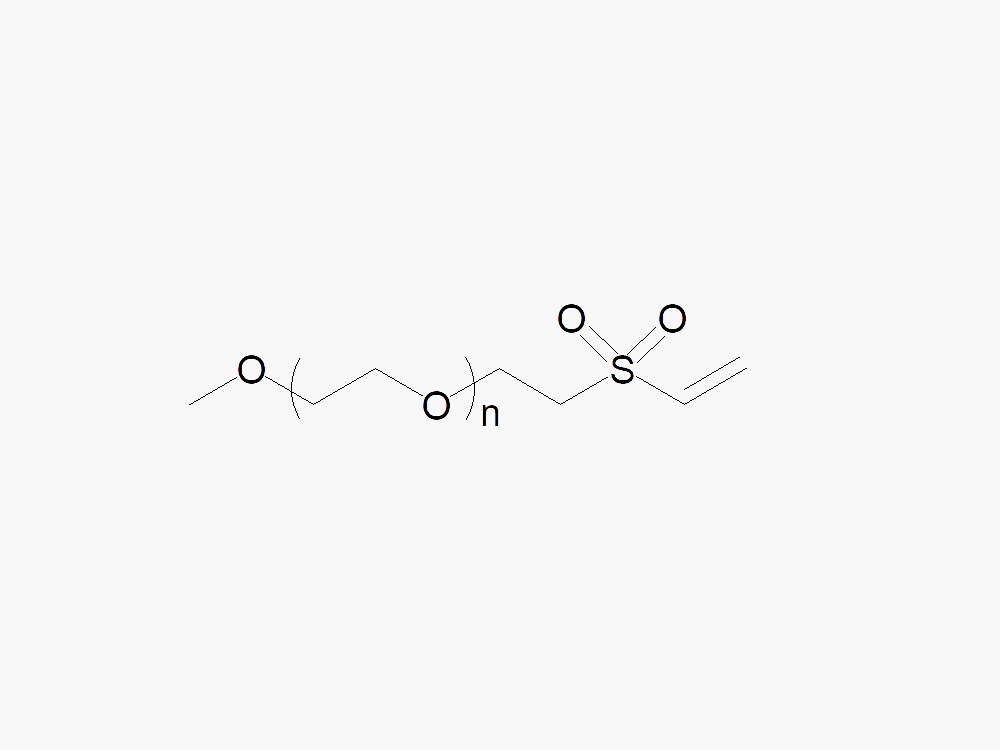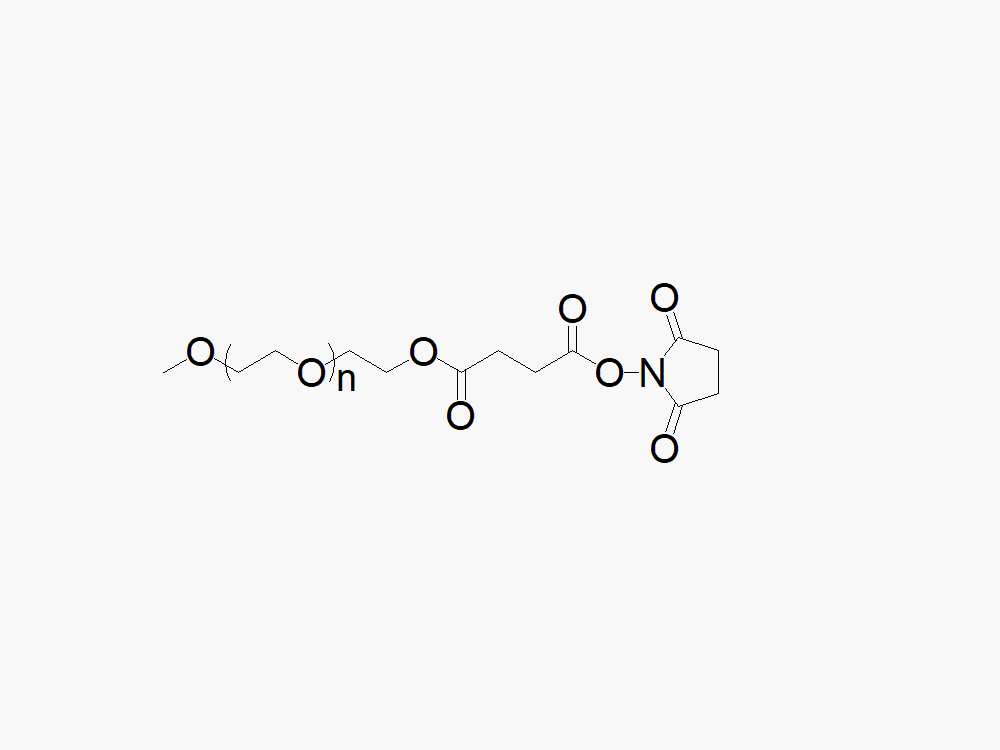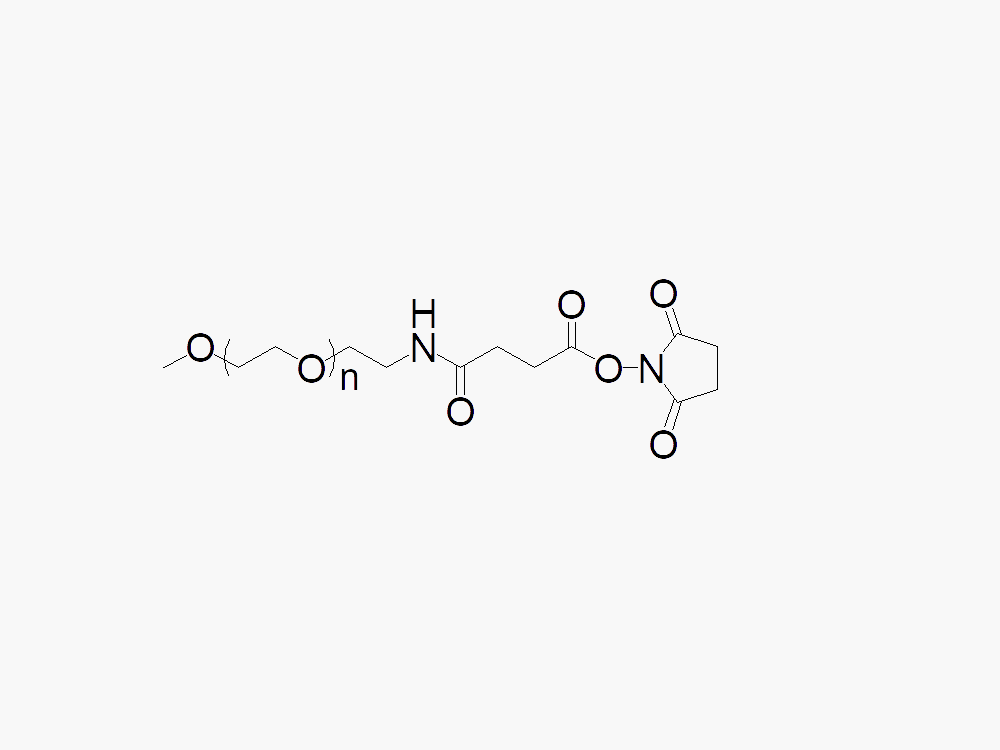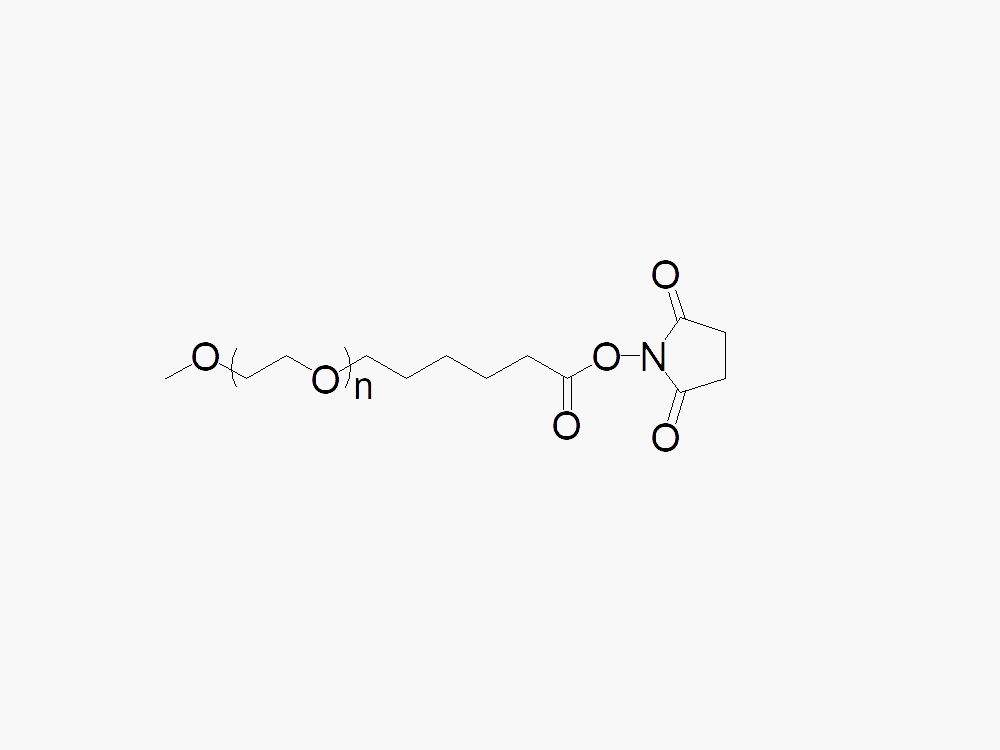产品中心
联系我们
销售专用:
地址:北京市海淀区西小口路66号中关村东升科技园C-1楼三层

Methoxy PEG Thiol
产品代号:
M-PEG-SH
产品纯度:
≥ 90%
包装规格:
1g, 10g, 100g等(特殊包装需收取分装费用)
分子量:
5000 Da-40000 Da,等
关键词:
所属分类:
科研客户小批量一键采购地址(小于5克)
- 产品描述
- 参考文献
-
甲氧基聚乙二醇巯基可在温和的反应条件下与半胱氨酸侧链上的巯基反应,进行聚乙二醇化。
键凯科技提供分装服务,需要收取分装费用,如果您需要分装为其他规格请与我们联系。
键凯科技同时提供其他分子量的M-SH产品,如你需要请与我司[email protected]联系。
键凯科技提供大批量生产产品及GMP级别产品,如需报价请与我们联系。
-
References:
1. Zhang, J., et al., Real-time and in-situ monitoring of Abrin induced cell apoptosis by using SERS spectroscopy, Talanta, 2019, V. 195, P. 8-16.
2. Li, X., et al., Efficient biofunctionalization of MoS2 nanosheets with peptides as intracellular fluorescent biosensor for sensitive detection of caspase-3 activity, Journal of Colloid and Interface Science, 2019.
3. Han, L., et al., Surface-enhanced resonance Raman scattering guided brain tumor surgery showing prognostic benefit in rat models, ACS applied materials & interfaces, 2019.
4. Xu, W., et al., PEGylated hydrazided gold nanorods for pH-triggered chemo/ photodynamic/ photothermal triple therapy of breast cancer, Acta Biomaterialia, 2018, V. 82, P. 171-183.
5. DiTullio, B.T., et al., Surface modification of polyaniline nanorods with thiol-terminated poly (ethylene oxide), Colloid and Polymer Science, 2018, 296(4), pp.637-645.
6. Luan, J., et al., Environmental Stability of Plasmonic Biosensors based on Natural vs. Artificial Antibody, Analytical chemistry, 2018.
7. Shao, B., et al., Nanogapped Au (core)@ Au-Ag (shell) structures coupled with Fe3O4 Magnetic nanoparticles for the detection of Ochratoxin A., Analytica Chimica Acta, 2018.
8. Wang, Y., et al., Enzymatically driven formation of palindromic DNA-Au nanoparticles for snowball assembly and colorimetric biosensing, Sensors and Actuators B: Chemical, 2018, 267, pp.328-335.
9. Su, B., et al., Effect of Retro‐Inverso Isomer of Bradykinin on Size‐Dependent Penetration of Blood–Brain Tumor Barrier, Small, 2018.
10. Peng, G., at al., N-terminal site-specific PEGylation enhances the circulation half-life of Thymosin alpha 1, Journal of Drug Delivery Science and Technology, 2018.
11. Li, H., et al., Combination of active targeting, enzyme-triggered release and fluorescent dye into gold nanoclusters for endomicroscopy-guided photothermal/photodynamic therapy to pancreatic ductal adenocarcinoma, Biomaterials, 2017.
12. Liu, D., et al., A Fully Integrated Distance Readout ELISA-Chip for Point-of-Care Testing with Sample-in-Answer-out Capability, Biosensors and Bioelectronics, 2017.
13. Yue, Q., et al., An EGFRvIII targeted dual-modal gold nanoprobe for imaging-guided brain tumor surgery, Nanoscale, 2017.
14. Kampert, T., et al., Phenotypically Screened Carbon Nanoparticles for Enhanced Combinatorial Therapy in Triple Negative Breast Cancer, Cellular and Molecular Bioengineering, 2017, 1-6.
15. Billingsley, M.M., et al., Antibody-nanoparticle conjugates to enhance the sensitivity of ELISA-based detection methods, PloS one, 2017, 12(5):e0177592.
16. Li, S.S., et al., Revealing chemical processes and kinetics of drug action within single living cells via plasmonic Raman probes, Scientific Reports, 2017, 7.
17. Srivastava, I., et al., Surface chemistry of carbon nanoparticles functionally select their uptake in various stages of cancer cells, Nano Research, 2017, 1-6.
18. Ni, D., et al., Oxygen Vacancy Enables Markedly Enhanced Magnetic Resonance Imaging-Guided Photothermal Therapy of a Gd (3+)-Doped Contrast Agent, ACS Nano, 2017.
19. Ma, N., et al., Shape-Dependent Radiosensitization Effect of Gold Nanostructures in Cancer Radiotherapy: Comparison of Gold Nanoparticles, Nanospikes, and Nanorods. ACS Applied Materials & Interfaces, 2017, 9(15):13037-48.
20. Ho, L.W., Yet al., Effect of Alkylation on the Cellular Uptake of Polyethylene Glycol-Coated Gold Nanoparticles. ACS Nano, 2017.
21. Chen, Q., et al., Surface-Enhanced Raman Scattering from Self-Assembled Film of Thiolated Peg-Modified Gold Nanoparticles, Journal of Applied Spectroscopy, 2017, 84(3):407-12.
22. Garcia, J., New strategies based on nanosystems to facilitate the crossing through biological barriers, Universitat de Barcelona, 2016.
23. Kennedy, S., et al., Sequential release of nanoparticle payloads from ultrasonically burstable capsules, Biomaterials, 2016, 75, P. 91-101.
24. Liu, H., et al., Microfluidic synthesis of QD-encoded PEGDA microspheres for suspension assay, J. Mater. Chem. B, 2016.
25. Wang, Y.L., et al., The ordering alignment of gold nanorods in liquid crystals and its applications to polarization-sensitive SERS. InJournal of Physics: Conference Series, 2016, 680:1, p. 012021.
26. Zhang, B., et al., Conductive and protein resistant polypyrrole films for dexamethasone delivery, Journal of Materials Chemistry B, 2016.
27. Shendi, D., et al., Tunable, Bioactive Protein Conjugated Hyaluronic Acid Hydrogels for Neural Engineering Applications. Journal of Materials Chemistry B., 2016.
28. Zhang, Q., et al., Gold Nanoparticle (AuNP)-Based Surface-Enhanced Raman Scattering (SERS) Probe of Leukemic Lymphocytes, Plasmonics, 2016, 1-8.
29. Tian, L., et al., Plasmonic Nanogels for Unclonable Optical Tagging, ACS Applied Materials & Interfaces, 2016, 8 (6), 4031-4041.
30. Hu, W., et al., Redox and pH dual responsive poly(amidoamine) dendrimer-poly(ethylene glycol) conjugates for intracellular delivery of doxorubicin, Acta Biomaterialia, 2016, 36, p: 241-253.
31. Ding, H., et al., Intracellular Temperature Imaging in Gold Nanorod-Assisted Photothermal Therapy with Luminescent Eu (III) Chelate Nanoparticles. Journal of Nanoscience and Nanotechnology, 2016, 16(4):3877-82.
32. Wang, F., et al., Polydopamine‐Functionalized Graphene Oxide Loaded with Gold Nanostars and Doxorubicin for Combined Photothermal and Chemotherapy of Metastatic Breast Cancer, Advanced Healthcare Materials, 2016.
33. Li, J., et al., SERS-active Plasmonic Nanoparticles with Ultra-small Interior Nanogap for Multiplex Quantitative Detection and Cancer Cell Imaging, Analytical Chemistry, 2016.
34. Pickenhahn, V. D., Regioselective thioacetylation of chitosan end-groups for nanoparticle gene delivery systemset al., Chem. Sci., 2015, 6, 4650-4664.
35. Fu, H., et al., Tumor‐Targeted Paclitaxel Delivery and Enhanced Penetration Using TAT ‐Decorated Liposomes Comprising Redox‐Responsive Poly(Ethylene Glycol), Journal of Pharmaceutical Science, 2015, 104(3): 1160-1173.
36. Sun, Y., et al., Patterning of graphite nanocones for broadband solar spectrum absorption, AIP Advances, 2015, 5, 067139.
37. Yuan, Y., et al., Topological nanocolloids with facile electric switching of plasmonic properties, Opt. Lett., 2015, 40, 5630-5633.
38. Wang, S., et al., Three-Photon Luminescence of Gold Nanorods and Its Applications for High Contrast Tissue and Deep In Vivo Brain Imaging. Theranostics, 2015, 5(3), 251-266.
39. Li, J., et al., Simple and Rapid Functionalization of Gold Nanorods with Oligonucleotides Using an mPEG-SH/Tween 20-Assisted Approach, Langmuir, 2015, 31 (28), 7869-7876.
40. Zhang, B., et al., Functionalised inherently conducting polymers as low biofouling materials, Biofouling, 2015, 31:6.
41. Wang, L., et al., Sea-Urchin-Like Au Nanocluster with Surface-Enhanced Raman Scattering in Detecting Epidermal Growth Factor Receptor (EGFR) Mutation Status of Malignant Pleural Effusion, ACS Applied Materials & Interfaces, 2015, 7 (1), 359-369.
42. Gao, L., et al., Plasmon-Mediated Generation of Reactive Oxygen Species from Near-Infrared Light Excited Gold Nanocages for Photodynamic Therapy in Vitro ACS Nano, 2014, 8(7), p: 7260–7271.
43. Li, J., Synergetic Approach for Simple and Rapid Conjugation of Gold Nanoparticles with Oligonucleotides, ACS Appl. Mater. Interfaces, 2014, 6(19), p. 16800–16807.
44. Mei, L., et al., Increased tumor targeted delivery using a multistage liposome system functionalized with RGD, TAT and cleavable PEG. International Journal of Pharmaceutics, 2014, 468(1–2), p. 26-38.
45. Hu, W., et al., Redox and pH-responsive poly (amidoamine) dendrimer-poly (ethylene glycol) conjugates with disulfide linkages for efficient intracellular drug release, Colloids Surf B Biointerfaces, 2014, 123, p:254-63.
46. Ai, X., et al., Thin-film hydration preparation method and stability test of DOX-loaded disulfide-linked polyethylene glycol 5000-lysine-di-tocopherol succinate nanomicelles, Asian Journal of Pharmaceutical Sciences, 2014, 9(5), p: 244-250.
47. Cui, J., et al., Nanoscale engineering of low-fouling surfaces through polydopamine immobilisation of zwitterionic peptides, Soft Matter, 2014, 10(15), 2656-2663.
48. Chen, S., et al., Nonionic fluorosurfactant as an ideal candidate for one-step modification of gold nanorods, Nanoscale, 2014, 6, 3197-3205.
49. Yuan, W., et al., Increased Delivery of Doxorubicin Into Tumor Cells Using Extracellularly Activated TAT Functionalized Liposomes: In Vitro and In Vivo Study, Journal of Biomedical Nanotechnology, 2014, 10:8, p. 1563-1573(11).
50. Tang, J., et al., Liposomes co-modified with cholesterol anchored cleavable PEG and octaarginines for tumor targeted drug delivery, Journal of Drug Targeting, 2014, 22:4.
51. Ai, X., et al., Star-Shape Redox-Responsive PEG-Sheddable Copolymer of Disulfide-Linked Polyethylene Glycol-Lysine-di-Tocopherol Succinate for Tumor-Triggering Intracellular Doxorubicin Rapid Release: Head-to-Head Comparison, Macromol. Biosci., 2014, 14: 1415–1428.
52. Ni, D., et al., Dual-targeting upconversion nanoprobes across the blood–brain barrier for magnetic resonance/fluorescence imaging of intracranial glioblastoma, ACS nano, 2014, 8(2):1231-42.
53. Yang, L., et al., Luminescent Ru(bpy)3 2+-doped silica nanoparticles for imaging of intracellular temperature, Microchimica Acta, 2013, 181:7, p. 743-749.
54. Taylor, W., et al., Protein Adsorption on Well-Characterized Polyethylene Oxide Brushes on Gold: Dependence on Molecular Weight and Grafting Density, Langmuir, 2013, 29(20), p: 6116–6122.
55. Molino, P. J., et al., Surface modification of polypyrrole/biopolymer composites for controlled protein and cellular adhesion, Biofouling, 2013, 29 (10), 1155-1167.
56. Yue, Z., et al., PEGylation of platinum bio-electrodes. Electrochemistry Communications, 2013, 27, 54-58.
57. Qin, H., et al., Gadolinium (III)-gold nanorods for MRI and photoacoustic imaging dual-modality detection of macrophages in atherosclerotic inflammation, Nanomedicine, 2013, 8.10: 1611-1624.
58. Kuai, R., et al., Targeted Delivery of Cargoes into a Murine Solid Tumor by a Cell-Penetrating Peptide and Cleavable Poly(ethylene glycol) Comodified Liposomal Delivery System via Systemic Administration, Mol. Pharmaceutics, 2011, 8(6), p: 2151–2161.
59. Wang, B., et al., Polymer Single Crystal Templated Janus Nanoparticles, Macromol. Rapid Commun., 2010, 31: 169–175.
60. Tsai, D.H., et al., Competitive Adsorption of Thiolated Polyethylene Glycol and Mercaptopropionic Acid on Gold Nanoparticles Measured by Physical Characterization Methods, Langmuir, 2010, 26 (12), 10325-10333.
61. Kuai, R., et al., Efficient Delivery of Payload into Tumor Cells in a Controlled Manner by TAT and Thiolytic Cleavable PEG Co-Modified Liposomes, Molecular Pharmaceutics, 2010, 7 (5), 1816-1826.
62. Taylor, W., et al., Producing High-Density High-Molecular-Weight Polymer Brushes by a “Grafting to” Method from a Concentrated Homopolymer Solution, Langmuir, 2010, 26 (17), 13954-13958.
63. Li, B., et al., Programmable Nanoparticle Assembly via Polymer Single Crystals, Macromolecules, 2009, 42 (24), 9394-9399.
64、Liu, Y., et al., Cathodic protected Mn2+ by NaxWO3 nanorods for stable magnetic resonance imaging-guided tumor photothermal therapy, Biomaterials, 2020, V. 234.
65.Guo, T., et al., Highly-selective detection of EGFR mutation gene in lung cancer based on surface enhanced Raman spectroscopy and asymmetric PCR, Journal of Pharmaceutical and Biomedical Analysis, 2020, 190,113522.
66. Wang, X.-M., et al., Exposure-time-dependent subcellular staging of gold nanoparticles deposition and vesicle destruction in mice livers, Nanomedicine: Nanotechnology, Biology and Medicine, 2021, V. 34.
67.Morales-Zavala, F., et al., In vivo micro computed tomography detection and decrease in amyloid load by using multifunctionalized gold nanorods: a neurotheranostic platform for Alzheimer's disease. Biomaterials Science. 2021.
68.Cai, X., et al., Synthesis of Au@ MOF Core-Shell Hybrids for Enhanced Photodynamic/Photothermal Therapy. Journal of Materials Chemistry B. 2021.
69.Ahmad, T., et al. Development of wound healing scaffolds with precisely-triggered sequential release of therapeutic nanoparticles.
70.Zhang, Y., et al., DNA-assembled visible nanodandelions with explosive hydrogen-bond breakage achieving uniform intra-tumor distribution (UITD)-guided photothermal therapy, Biomaterials, 2022, 121381.
71.Robert, J, et al., Coiled-Coil Peptide-Based Assembly of a Plasmonic Core-Satellite Polymer-Metal Nanocomposite as an Efficient Photothermal Agent, NANOTODAY-D-22-00764, 2022.
72.Robert, J., et al., Coiled-coil peptide-based assembly of a plasmonic core-satellite polymer-metal nanocomposite as an efficient photothermal agent for drug delivery applications, Journal of Colloid and Interface Science, 641, 2023.
产品询价






